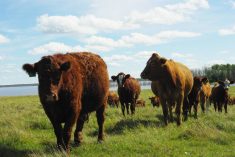Chicago | Reuters — Beef prices will keep trending lower, analysts said after the government’s semi-annual cattle inventory report on Friday showed the U.S. cattle herd as of Jan. 1 grew three per cent from a year ago, to a five-year high.
Healthy pastures, more-affordable grain and record-high cattle prices a year ago encouraged ranchers to beef up their herds. Rebuilding is aiding recovery of the herd that at one point in 2014 had fallen to a 63-year low after years of drought.
As a result, retail beef prices have declined seven months in a row to $5.97/lb. in December versus $6.31 a year earlier, based on the government’s most recent data (all figures US$).
Read Also

U.S. grains: Soy futures post biggest monthly gain in nearly five years on China trade optimism
U.S. soybean futures climbed to a 15-month high and posted their biggest monthly gain in nearly five years on Friday following a rally fueled by the prospect of revived exports to China.
Analysts look for that pattern to continue when beef is pitted against competitively priced pork and chicken during the highly-anticipated spring grilling season.
Friday’s U.S. Department of Agriculture twice-yearly cattle inventory report showed the U.S. cattle herd as of Jan. 1 up three per cent from a year earlier at 91.988 million head. That exceeded analysts’ average forecasts of a two per cent increase from 89.143 million in January 2015.
Friday’s USDA data showed the Jan. 1 cattle population was the highest since 92.9 million in 2011.
“Clearly the sector has turned,” said Chicago-based Linn Group analyst John Ginzel. The industry “is waving a red flag” that it is responding to strong economic incentives to expand their breeding herd, he said.
Rich Nelson, chief strategist with Allendale Inc. in McHenry, Ill., partly attributed some of the higher-than-anticipated results to downward revisions to the government’s January 2015 report.
Still, he said, the availability of more meat will cause Allendale to raise their beef production estimate for 2016 to 2.5 per cent higher, up from their initial two per cent higher view.
Analysts said for consumers, active herd expansion suggests beef prices have likely peaked and will continue to grind lower.
“Depending on how fast the feeding sector draws younger cattle into formal feeding programs, those cattle will likely be placed at heavier weights and will likely increase available tonnage,” said Ginzel.
Typically, USDA’s twice-yearly cattle report does not sway Chicago Mercantile Exchange live cattle futures traders that tend to focus more on near-term market factors such as late Friday’s wholesale beef and slaughter cattle prices.
But because of bearish nature of the data, Ginzel looks for it to possibly pressure late-2016 and early-2017 trading months.
— Theopolis Waters reports on livestock markets for Reuters from Chicago. Additional reporting for Reuters by Michael Hirtzer.











